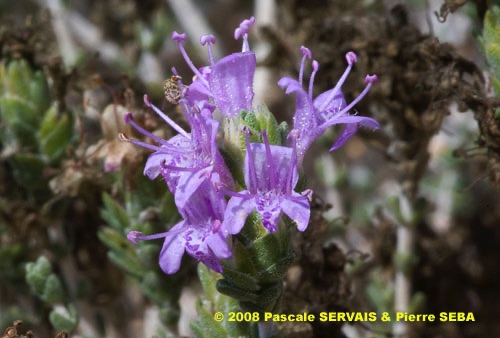
Thymus capitatus (L.) Hoffmanns. & Link
Fam. : Lamiaceae
© Pascale SERVAIS & Pierre SEBA, 2019. Tilo Botanica: Flore de Tilos et du Dodécanèse / Flora of Tilos and of the Dodecanese
English translation by Brenda Bradbury, Howard Bradbury and Stéphane Léonard
Sous-arbrisseau hermaphrodite, aromatique, aux rameaux rigides, dressés ou étalés, couverts de poils blancs à l’état juvénile.
Feuilles opposées décussées, simples, linéaires, dentées, étroites, charnues, presque glabres, ponctuées de glandes, à bords plats, de 2 tailles très différenciées: les plus longues de 10 mm au plus, avec à leur aisselle un groupe de feuilles bien plus courtes qui sont les seules à se maintenir sur la plante à la saison sèche. Bractées vertes, souvent teintées de rouge, ovales, très imbriquées, formant une tête en forme de cône.
Fleurs à symétrie bilatérale, rose pourpré vif ou roses, rarement blanches, de 7 à 10 mm de long, réunies en têtes terminales à la forme caractéristique de massue. Corolle à 2 lèvres, la lèvre inférieure trilobée. Calice aplati, à 20 à 22 nervures. 4 étamines très longues. Ovaire supère.
Fruits, 4 akènes.
___________________________
Shrublet hermaphrodite, aromatic. Branches rigid, erect or spread out, covered in white hairs in youthful state.
Leaves opposite decussate, simple, linear, toothed, narrow, fleshy, almost glabrous, with scattered glands, with flat edges, of 2 very different sizes: the longest ones 10 mm at most, with at their axil a group of much shorter leaves which are the only ones to stay on the plant during the dry season. Bracts green, often tinted of red, ovate, very imbricate, forming a cone-shaped head.
Flowers bilaterally symmetrical, bright purple pink or pink, seldom white, from 7 to 10 mm long, joined together in terminal heads in the distinctive shape of bludgeon. Corolla with 2 lips, the lower one three-lobed. Calyx flattened, with 20 to 22 veins. 4 very long stamens. Ovary superior.
Fruits, 4 achenes.
Descripteurs / Identifying features
1
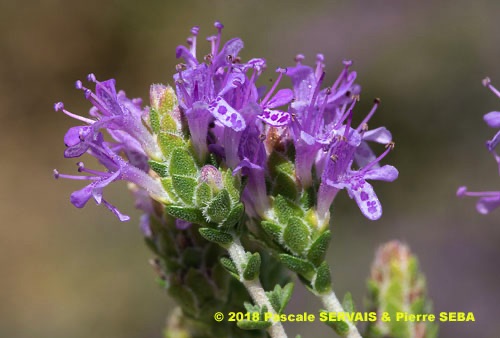
2
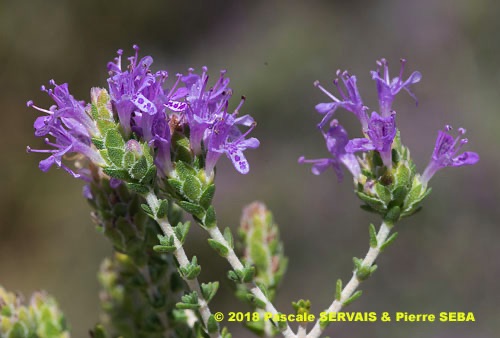
3
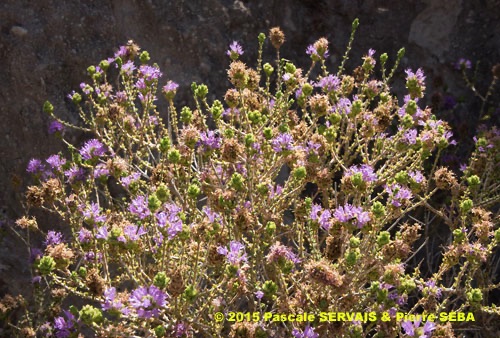
4
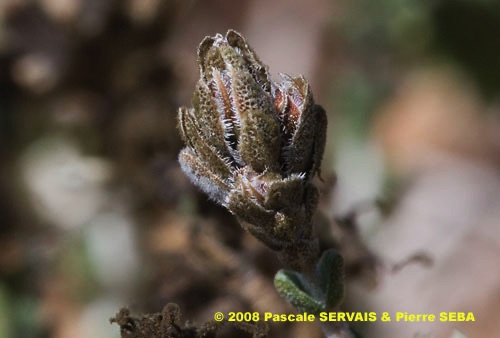
5
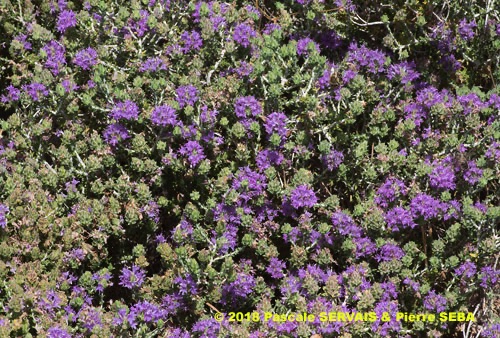
6
Étymologie / Etymology :
Thymus : emprunt du latin thymus, -i (nom) = le thym, nom donné à la
plante par Pline, naturaliste latin mort en 79 apr. J.-C., forme latinisée
du grec ancien θύμος, -ου (nom) [ < θύω (verbe) = brûler des parfums
lors d’un sacrifice ] = le thym, nom donné à la plante par Dioscoride,
médecin et botaniste grec mort en 90 apr. J.-C., en référence à la forte
odeur de cette plante aromatique.
Capitatus : emprunt du latin capitatus, -a, -um (adj.)
[ < caput, -itis (nom) = la tête ] = qui a une grosse tête, en forme de
tête, en référence à la forme de l’inflorescence.
Thymus : borrowed from Latin thymus, -i (noun) = thyme, name given to
the plant by Plinius, Latin naturalist died in 79 AD, Latinized form of the
Classical Greek θύμος, -ου (noun) [ < θύω (verb) = to burn perfumes
at the time of a sacrifice ] = thyme, name given to the plant by
Dioscorides, Greek doctor and botanist died in 90 AD, referring to the
strong smell of this aromatic plant.
Capitatus : borrowed from Latin capitatus, -a, -um (adj)
[ < caput, -itis (noun) = head ] = having a big head, head-shaped,
referring to the shape of the inflorescence.
Synonymes / Synonyms :
Coridothymus capitatus (L.) Rchb.
Thymbra capitata (L.) Cav.
Satureja capitata L.
Noms vernaculaires / Common names :
Noms français / French names :
Thym à têtes — Thym capité.
Noms grecs / Greek names :
Θυμάρι — Θυμάρι Σητείας — Θυμάρι Τήνου —
Θυμάρι το κεφαλωτόν — Θύμος ο κεφαλωτός.
Noms anglais / English names :
Conehead thyme — Headed savory — Mediterranean thyme —
Moroccan wild thyme — Persian hyssop — Spanish oregano.
Noms allemands / German names :
Kopfiger Thymian — Zatar Corido — Zuheif.
Noms espagnols / Spanish names :
Tomillo — Tomillo aceitunero — Tomillo andaluz —
Tomillo cabezon — Tomillo carrasqueño — Tomillo colorao —
Tomillo tinajero.
Nom italien / Italian name :
Timo arbustivo.
Habitat :
Lieux pierreux.
Stony places.
Île / Island :
Tilos.
Hauteur / Height range :
De 20 cm à 50 cm.
From 20 cm to 50 cm.
Floraison / Flowering time :
D’avril à novembre.
From April to November.
Groupe / Classification :
Dicotylédones.
Dicotyledons.
Pérennité / Lifespan :
Vivace.
Perennial.
Description :
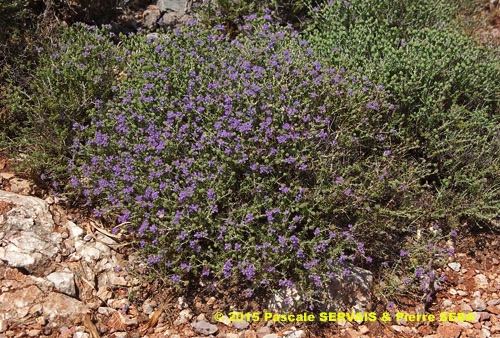
7
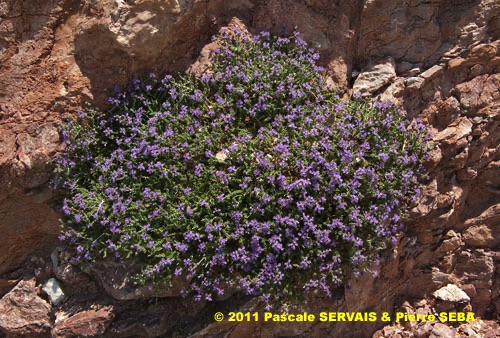
8
Photo 1 :
Localisation / Location : Tilos, Megalochorio, Erystos
Date : 17/09/2008
GPS : Lat. 36,43365° N / Long. 27,34399° E / Alt. 15 m
Type : Photographie numérique / Digital Photograph (10 mégapixels)
Photo 2 :
Localisation / Location : Tilos, Livadia, Aghios Stephanos
Date : 30/06/2018
GPS : Lat. 36,41141° N / Long. 27,40163° E / Alt. 2 m
Type : Photographie numérique / Digital Photograph (24 mégapixels)
Photo 3 :
Localisation / Location : Tilos, Livadia, Aghios Stephanos
Date : 30/06/2018
GPS : Lat. 36,41141° N / Long. 27,40163° E / Alt. 2 m
Type : Photographie numérique / Digital Photograph (24 mégapixels)
Photo 4 :
Localisation / Location : Tilos, Megalochorio, Chemin de Skafi
Date : 10/09/2015
GPS : Lat. 36,45971° N / Long. 27,34999° E / Alt. 99 m
Type : Photographie numérique / Digital Photograph (24 mégapixels)
Photo 5 :
Localisation / Location : Tilos, Megalochorio, Erystos
Date : 17/09/2008
GPS : Lat. 36,43365° N / Long. 27,34399° E / Alt. 15 m
Type : Photographie numérique / Digital Photograph (10 mégapixels)
Photo 6 :
Localisation / Location : Tilos, Livadia, Aghios Stephanos
Date : 30/06/2018
GPS : Lat. 36,41141° N / Long. 27,40163° E / Alt. 2 m
Type : Photographie numérique / Digital Photograph (24 mégapixels)
Photo 7 :
Localisation / Location : Tilos, Livadia, Chemin de Lethra
Date : 04/06/2011
GPS : Lat. 36,43255° N / Long. 27,39041° E / Alt. 99 m
Type : Photographie numérique / Digital Photograph (10 mégapixels)
Photo 8 :
Localisation / Location : Tilos, Megalochorio, Aghios Pandeleimonas
Date : 07/06/2011
GPS : Lat. 36,45728° N / Long. 27,30088° E / Alt. 120 m
Type : Photographie numérique / Digital Photograph (10 mégapixels)

Google Maps
Google Maps
Google Maps
Google Maps
Google Maps
Google Maps
Google Maps
Google Maps